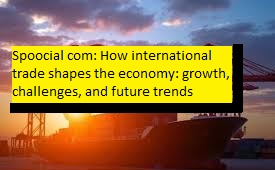Spoocial com: How international trade shapes the economy: Growth, challenges, and future trends
1. Driving Economic Growth 🚀
- Expanding markets & efficiency
Trade enables countries to sell goods and services beyond their borders, tapping into broader customer bases and economies of scale helping companies grow faster than they could domestically. - Specialization through comparative advantage
Nations can focus on producing what they do best, improving efficiency and output, which boosts global welfare and raises living standards. - Spreading technology, innovation & ideas
Cross-border exchanges don’t just transfer goods they carry knowledge, AI, and tech. This accelerates productivity gains across sectors and countries. spoocial com: how international trade shapes the economy: growth, challenges, and future trends
2. Navigating Persistent Challenges
A. Protectionism & Trade Wars
When countries impose tariffs or quotas, costs rise, supply chains suffer, and uncertainty increases—which harms growth. Economies are especially vulnerable when major players like the U.S. and China engage in tit-for-tat policies.
B. Supply Chain Disruptions
Events like pandemics or geopolitical crises have exposed over-reliance on “just‑in‑time” production. In response, companies are shifting toward “just‑in‑case” models—diversifying suppliers and boosting resilience.
C. Income Inequality & Job Displacement
Trade may reduce costs overall, but certain domestic sectors can shrink, affecting workers and communities. Policy measures are needed to support those impacted by structural shifts .
D. Environmental & Social Pressures
Global trade has triggered regulations (e.g., EU due diligence rules) to enforce sustainability and human rights standards. While these foster more responsible supply chains, they also raise compliance costs .
3. Shaping the Future: Emerging Trends
| Trend | Description |
|---|---|
| Digitization | E‑commerce, blockchain bills of lading, AI logistics, and digital customs processes simplify trade operations—though integration and legal standards are crucial |
| Regional Trade Blocs | Deals like USMCA, CPTPP, RCEP, AfCFTA foster trade stability, reducing reliance on multilateral platforms |
| Supply Chain Resilience | Firms diversify away from single-source hubs, reshoring, and building buffer logistics to guard against future disruptions |
| Sustainable Trade | Eco-conscious trade rules are rising—carbon border taxes, green certifications, and ethical procurement are becoming mainstream |
| Multipolar Trade Flows | Major powers like China, India, and the EU are shaping a multipolar trade landscape, reducing dependency on any one country |
4. Broader Economic Impacts
- Confidence & investment: Uncertainty from trade tensions leads to slower investment and GDP growth—World Bank forecasts global growth of only 2.3% in 2025 amid rising tariffs.
- Inflation dynamics: Tariffs and supply constraints fuel prices. While central banks may tolerate this without triggering recession, inflation remains a concern .
- Geopolitical influence: Trade ties shape alliances and leverage. Countries with strategic supply chains (e.g., semiconductors, green minerals) gain geopolitical advantage .
5. What Lies Ahead?
- Adoption of digital trade infrastructure will broaden access for small businesses and reduce red tape.
- Regional blocs may see deeper integration and interdependence within Afro-Asian and Latin American markets.
- New trade frontiers include sustainable commodities (like green minerals) and digital services.
- Policy support for adjustment could mitigate inequality and cushion workers amid structural change.
- Geopolitical balance will be shaped by cooperation—countries may engage in trade even as strategic competition persists.
✅ Final Thoughts
International trade remains a powerful engine for growth—yet it brings complexity and disruption. Driving forces like digitalization, regional agreements, and sustainability offer opportunity, but protectionist backlashes and inequality risks loom large. Adapting economies must find the right mix: embracing trade-driven innovation, while building resilient systems and inclusive social frameworks. spoocial com: how international trade shapes the economy: growth, challenges, and future trends
